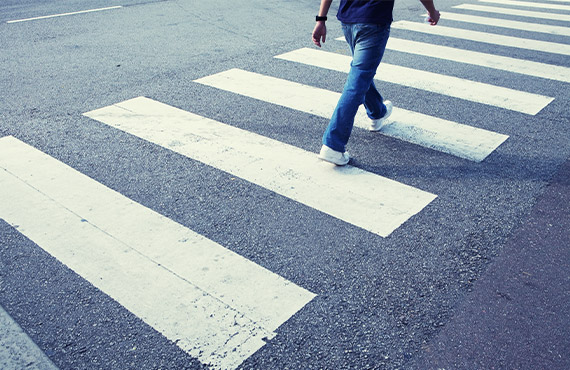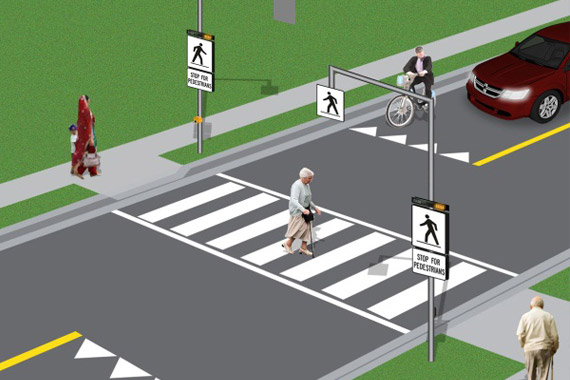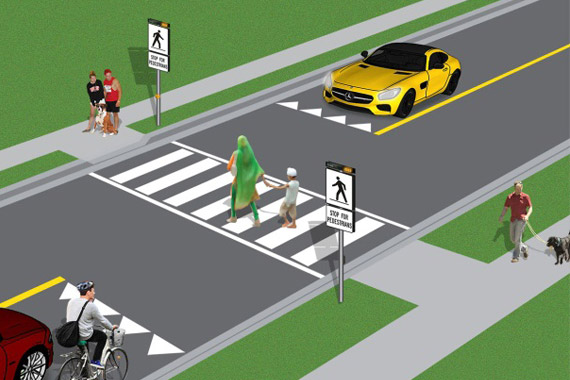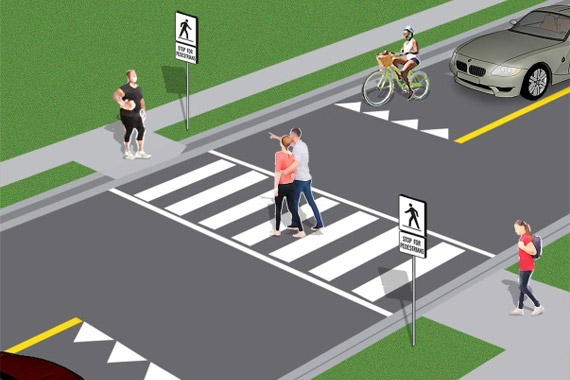The town developed the Pedestrian Safety Program (pdf), with the goal of addressing safety issues and establishing where and what type of pedestrian crossings are needed throughout town. Through the program, the town identified over 170 candidate locations.
Pedestrian signals
Pedestrian signal displays occur at some crosswalks and consist of:
- a walking person symbol indicating "walk"
- a flashing hand symbol, sometimes accompanied by a countdown, indicating "don't walk" unless the pedestrian entered the crosswalk during the "walk" phase
- a static hand symbol indicating "don't walk"
The white symbol of a walking person is the signal that tells pedestrians that they may begin to cross the road. Pedestrians may begin crossing the road at the crosswalk whenever the walk signal is showing.
The flashing "don't walk" hand signal means that pedestrians should not begin crossing the road. This signal is sometimes combined with a countdown timer and has the same meaning.
If a pedestrian enters the crosswalk when the walk signal is on, they continue to have the right of way when the walking person light ends and the flashing hand or countdown begins. If you started crossing with the walk signal, continue your crossing – you will have enough time to complete your crossing before the signal changes to the "don't walk" phase.
The countdown signal, also known as a pedestrian countdown signal (PCS), provides a numeric count down display that indicates the number of seconds remaining for a pedestrian to complete their crossing of a street. The countdown shows the length of time between the walking person signal and the steady hand signal. These devices provide pedestrians with more information to assist them with a safer passage across the street. The initial countdown display value is dependent on the length of the crosswalk.
New traffic signals installed since 2008 have been equipped with pedestrian countdown signals. Each year, these devices are also installed at select busy crosswalks at existing signalized locations.
The orange steady hand signal means "don't walk" and is displayed before the conflicting traffic movements are allowed to start. When faced with a "don't walk" signal the pedestrian should press the push button and wait to cross the roadway.
At selected road crossings at traffic signal locations, Oakville uses Accessible Pedestrian Signals (APS) in coordination with the CNIB Foundation, to assist pedestrians who are visually impaired. These signals advise visually impaired persons when they can cross the intersection and in which direction. If pedestrians hear a “cuckoo” sound, they can cross in a north/south direction. A “chirp” or a music melody means they can cross in an east/west direction. Additional verbal messages and location information may be provided.
-
- Construction Projects
-
- Roads, Bridges & Storm Sewers
- Bridge Road Reconstruction
- Burloak Drive Grade Separation
- Burnhamthorpe Road East Urbanization
- Burnhamthorpe Road Rehabilitation
- Culvert Rehabilitation Near 1296 Lakeshore Road West
- Drainage Improvements Near 79 Brookfield Road
- Kerr Street Grade Separation
- Royal Windsor Drive Bridge Rehabilitation
- Saville-Seaton Area Storm Drainage Improvement Project
- Sixth Line Widening
- Speers Road Widening
- St. Judes Cemetery and Trafalgar Lawn Cemetery Culvert Replacements
- Westminster Drive Storm Sewer and Road Resurfacing
- Woodhaven Park Drive Storm Sewer and Road Resurfacing
- York Street and Wallace Road Reconstruction
- Stream & Shoreline Projects
- Taxis & Limos
- Road Corridor Permits
- Oakville Transit
Pedestrian crossovers
A pedestrian crossover is a type of crossing where drivers and cyclists are required to stop for pedestrians intending to cross the road.
Check out this short video, courtesy of the City of Ottawa.

Differences between pedestrian crossovers and crosswalks
While crosswalks and crossovers serve similar functional purposes, stopping traffic to allow pedestrians to cross a roadway, there are also some differences you should be aware of.
Pedestrian crossovers
- Can be found at any stretch of roadway, not necessarily at an intersection
- Always have "ladder" style stripes that mark the crossing area
- Always have roadside signage that says "Stop for Pedestrians"
- Always have pavement markings to show where cars and/or cyclists must stop
- Sometimes have lights or overhead signage
- Motorists must wait for pedestrians to cross the full width of the road before proceeding
Crosswalks
- Found at a regular traffic signal, stop sign, school crossing or other intersection
- Sometimes have "ladder" style stripes that mark the crossing area
- Motorists do not have to wait for pedestrians to cross the full width before proceeding
How to use a pedestrian crossover
It is the responsibility of drivers, cyclists and pedestrians to understand and follow the rules of the road. Here are some guidelines:
- Look for the signs and slow down. Be prepared to stop for pedestrians waiting to cross the road
- Stop behind the yield line. You do not need to stop if you can see there is no-one waiting to cross
- Make eye contact so pedestrian sees you
- Wait until pedestrian completely crosses road before proceeding
- You may proceed once the pedestrian has reached the other side, even if the lights are still flashing, as long as you have looked to make sure no-one else is intending to cross the road
- Stand close to the curb. If the crossover has button-activated lights, push the button
- Hold your hand out in front of you indicating you are waiting to cross the road
- Look both ways and wait for traffic to stop
- Make eye contact to ensure driver sees you before you step onto the road
- When crossing, follow rules for pedestrians; dismount and walk your bike. Learn more about safe cycling.
- When riding with traffic, follow rules for drivers
Types of pedestrian crossovers in Oakville
All pedestrian crossovers in Oakville are marked by lines on the road, a clear place showing where motorists should stop, roadside signs and, in most cases, flashing lights.
Pedestrian crossovers may be designed in different styles or classifications. In Oakville, you will find Type B, Type C and Type D.

Type B
- Lines that mark the crossing area
- Clear place for motorists and cyclists to stop
- Roadside signs
- Flashing lights
- Overhead signs

Type C
- Lines that mark the crossing area
- Clear place for motorists and cyclists to stop
- Roadside signs
- Flashing lights

Type D
- Lines that mark the crossing area
- Clear place for motorists and cyclists to stop
- Roadside signs
Existing pedestrian crossover locations
The town's first pedestrian crossover was implemented in January 2017 at Navy Street and Church Street (Type B). The recently completed Pedestrian Safety Program has recommended over 170 pedestrian crossover locations throughout the town that will be implemented over the next 10-15 years.
New pedestrian crossovers to be implemented by the end of 2025:
- Postmaster Drive at Crosstown Heritage Trail (north of Mariposa Road) – Type C
- Parkglen Avenue at Crosstown Heritage Trail (south of Highcroft Road) – Type D
- Fourth Line at Crosstown Heritage Trail (north of Waubanoka Way) – Type C
- Allan Street at Wallace Park (north of Wallace Park Lane) – Type D
- Ridge Landing at Crosstown Heritage Trail – Type D
- Grand Oak Trail at Crosstown Heritage Trail (north of Blue Holly Crescent) – Type C
- Baronwood Drive at Crosstown Heritage Trail (north of Sequoia Way) – Type D
- Oakhaven Drive at Crosstown Heritage Trail (north of Pinecliff Road) – Type D
- Stratus Drive at Crosstown Heritage Trail (south of Falling Green Drive) – Type D
- Proudfoot Trail at Crosstown Heritage Trail (north of Waubanoka Way) – Type B
- Munn’s Avenue and Sprucedale Drive – Type D
- Lakeshore Road and Balsam Drive – Type B
- Abbeywood Drive at Glen Abbey Trail (west of Fieldstone Cir) – Type B
- Lancaster Drive at Sheridan Public School (East of Harcroft Crt) – Type D
- Bayshire Drive at St. Marguerite Catholic Elementary School (west of Creekwood Trail) – Type D
- Grosvenor Street and Kimberly Drive – Type D
- River Oaks Boulevard E at Nipigon Trail North Bank (west of Nipigon Drive) – Type B
- McDowell Avenue at Crosstown Heritage Trail – Type D
- Wynten Way at Avonhead Ridge Trail (east of Thoresby Drive) – Type D
- Munn’s Avenue at River Oaks Public School (west of O’Donoghue Avenue) – Type D
- Grand Boulevard and Valleybrook Drive – Type B
- Montrose Abbey Drive at Glen Abbey Trail (south of Pleasant View Court) – Type D
- Devon Road and Elmhurst Avenue – Type C
- Wynten Way at Clearview Park Walk (north of Sir David Drive) – Type D
- Grosvenor Street and Grange Road – Type D